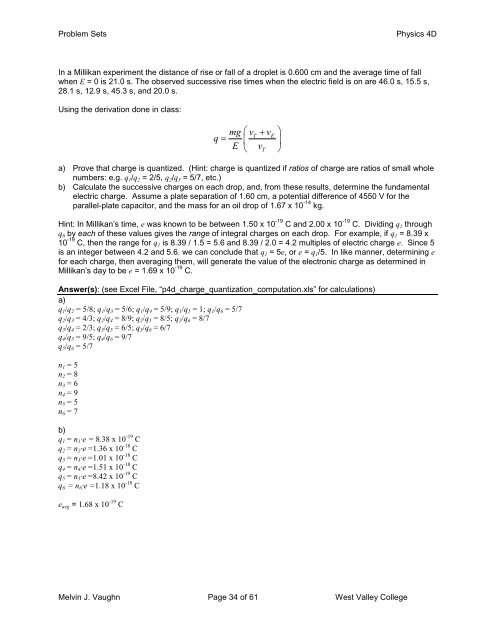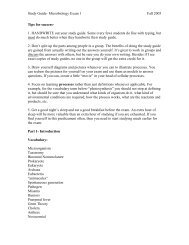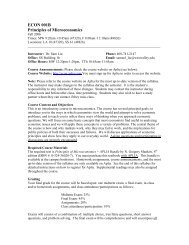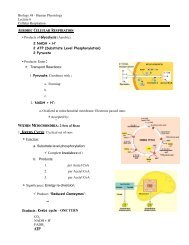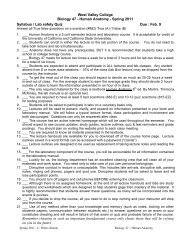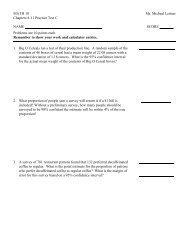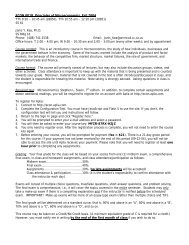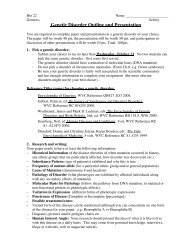Answers to Selected Problems - West Valley College
Answers to Selected Problems - West Valley College
Answers to Selected Problems - West Valley College
You also want an ePaper? Increase the reach of your titles
YUMPU automatically turns print PDFs into web optimized ePapers that Google loves.
Problem Sets Physics 4D<br />
In a Millikan experiment the distance of rise or fall of a droplet is 0.600 cm and the average time of fall<br />
when E = 0 is 21.0 s. The observed successive rise times when the electric field is on are 46.0 s, 15.5 s,<br />
28.1 s, 12.9 s, 45.3 s, and 20.0 s.<br />
Using the derivation done in class:<br />
q<br />
mg v v <br />
T E<br />
<br />
E vT<br />
<br />
a) Prove that charge is quantized. (Hint: charge is quantized if ratios of charge are ratios of small whole<br />
numbers: e.g. q1/q2 = 2/5, q2/q3 = 5/7, etc.)<br />
b) Calculate the successive charges on each drop, and, from these results, determine the fundamental<br />
electric charge. Assume a plate separation of 1.60 cm, a potential difference of 4550 V for the<br />
parallel-plate capaci<strong>to</strong>r, and the mass for an oil drop of 1.67 x 10 -14 kg.<br />
Hint: In Millikan’s time, e was known <strong>to</strong> be between 1.50 x 10 -19 C and 2.00 x 10 -19 C. Dividing q1 through<br />
q6 by each of these values gives the range of integral charges on each drop. For example, if q1 = 8.39 x<br />
10 -19 C, then the range for q1 is 8.39 / 1.5 = 5.6 and 8.39 / 2.0 = 4.2 multiples of electric charge e. Since 5<br />
is an integer between 4.2 and 5.6. we can conclude that q1 = 5e, or e = q1/5. In like manner, determining e<br />
for each charge, then averaging them, will generate the value of the electronic charge as determined in<br />
Millikan’s day <strong>to</strong> be e = 1.69 x 10 -19 C.<br />
Answer(s): (see Excel File, “p4d_charge_quantization_computation.xls” for calculations)<br />
a)<br />
q1/q2 = 5/8; q1/q3 = 5/6; q1/q4 = 5/9; q1/q5 = 1; q1/q6 = 5/7<br />
q2/q3 = 4/3; q2/q4 = 8/9; q2/q5 = 8/5; q2/q6 = 8/7<br />
q3/q4 = 2/3; q3/q5 = 6/5; q3/q6 = 6/7<br />
q4/q5 = 9/5; q4/q6 = 9/7<br />
q5/q6 = 5/7<br />
n1 = 5<br />
n2 = 8<br />
n3 = 6<br />
n4 = 9<br />
n5 = 5<br />
n6 = 7<br />
b)<br />
q1 = n1∙e = 8.38 x 10 -19 C<br />
q2 = n2∙e =1.36 x 10 -18 C<br />
q3 = n3∙e =1.01 x 10 -18 C<br />
q4 = n4∙e =1.51 x 10 -18 C<br />
q5 = n5∙e =8.42 x 10 -19 C<br />
q6 = n6∙e =1.18 x 10 -18 C<br />
eavg = 1.68 x 10 -19 C<br />
Melvin J. Vaughn Page 34 of 61 <strong>West</strong> <strong>Valley</strong> <strong>College</strong>


